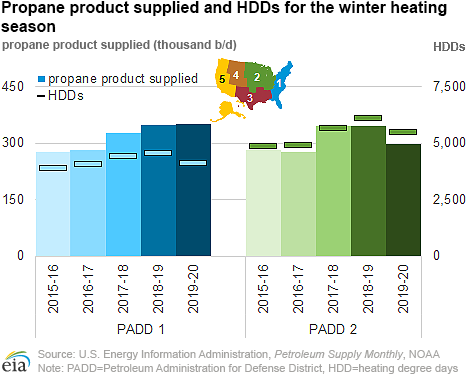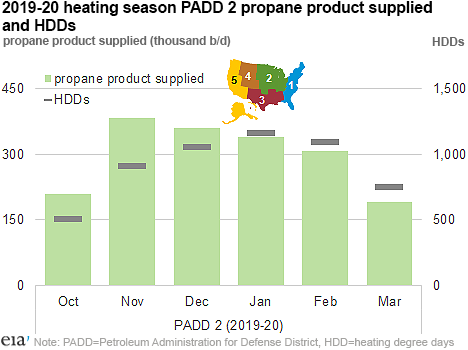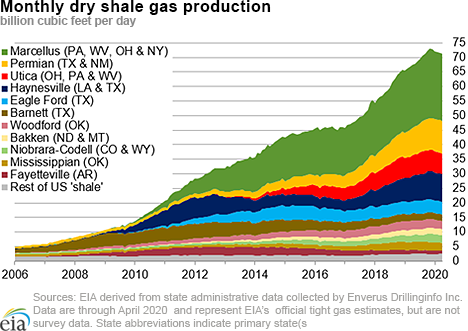In the News:
U.S. Winter 2019–20 Propane Consumption Lower than Last Year
U.S. propane product supplied (a proxy for consumption) averaged 648,000 barrels per day (b/d) in winter 2019–20 (October–March), the lowest level since winter 2016–17, according to EIA’s recently released May Petroleum Supply Monthly. Similar to natural gas, propane is used as a space heating fuel. Five million, or about 4.2%, U.S. households report propane as their primary space heating fuel, and rural areas in the Northeast and Midwest account for most residential and commercial propane consumption. Propane can also be consumed for water heating, cooking, and clothes drying. In the industrial sector, propane is used primarily as a feedstock for petrochemical plants as well as for heating barns and coops, grain drying, and other uses.
Propane inventories typically build from April to October and then draw down as temperatures begin to drop. In some years, when the corn harvest is delayed or corn grain moisture is too high, an early seasonal spike in demand may occur. Propane demand typically aligns with propane weighted-heating degree days (HDDs), reflecting the large share of consumption for space heating.
In the East Coast (Petroleum Administration for Defense District (PADD) 1), propane product supplied has been increasing over the past five winter heating seasons, reaching 350,000 b/d for the 2019–20 heating season—3,600 b/d higher than the 2018–19 heating season despite a relatively warmer winter. NOAA reported 4,109 HDDs for the 2019–20 heating season, which was 446 HDDs (-9.7%) fewer than in the previous winter. This slight increase in propane demand may be a result of an increase in the number of houses that consume propane for space heating as well as growing non-space heating demand for agricultural applications, such as poultry farms.
In the Midwest (PADD 2), on the other hand, total propane consumption declined despite high levels of consumption early in the winter season. PADD 2 propane product supplied decreased to 298,000 b/d this past winter, a 13.9% drop relative to the 2018–19 winter. The decrease in propane product supplied this past winter corresponds with HDDs for the 2019–20 heating season, which was 9.9% lower than the previous heating season.
Propane consumption in PADD 2 in winter 2019–20 started strong, with November product supplied rising 13.7% higher than in November 2018. The sharp increase in PADD 2 early-winter demand was a result of increased propane fuel use at commercial grain dryers because the delayed corn harvest resulted in grain with moisture content significantly higher than average. Additional early-season demand was the result of cooler-than-normal weather in October and November, which had 30% more HDDs than the five-year average. Both the drying demand and the above-average heating demand ended in December 2019. High snow fall and declining corn prices also put an end to the grain harvest and grain drying activity by about the second week of December 2019, and USDA reported just 82.9% of corn crops were harvested across the Corn Belt. NOAA reported December and January HDDs, peak space-heating months, at 3% lower than the five-year average.
Overview:
(For the week ending Wednesday, May 27, 2020)
- Natural gas spot prices rose at most locations this report week (Wednesday, May 27 to Wednesday, June 3). The Henry Hub spot price rose from $1.72 per million British thermal units (MMBtu) last Wednesday to $1.77/MMBtu yesterday.
- At the New York Mercantile Exchange (Nymex), the June 2020 contract expired last Wednesday at $1.722/MMBtu. The July 2020 contract price decreased to $1.821/MMBtu, down 6¢/MMBtu from last Wednesday to yesterday. The price of the 12-month strip averaging July 2020 through June 2021 futures contracts declined 1¢/MMBtu to $2.438/MMBtu.
- The net injections to working gas totaled 102 billion cubic feet (Bcf) for the week ending May 29. Working natural gas stocks totaled 2,714 Bcf, which is 39% more than the year-ago level and 18% more than the five-year (2015–19) average for this week.
- The natural gas plant liquids composite price at Mont Belvieu, Texas, rose by 11¢/MMBtu, averaging $4.46/MMBtu for the week ending June 3. The prices of propane, isobutane, butane, and ethane rose by 1%, 4%, 6%, and 9%, respectively. The price of natural gasoline fell by 12% in response to weakened demand for diluent by heavy crude oil producers.
- According to Baker Hughes, for the week ending Tuesday, May 26, the natural gas rig count decreased by 2 to 77. The number of oil-directed rigs fell by 15 to 222. The total rig count decreased by 17, and it now stands at 301.
Prices/Supply/Demand:
Prices end the week high because of warm weather in the west and a tropical storm in the Gulf of Mexico. This report week (Wednesday, May 27 to Wednesday, June 3), the Henry Hub spot price rose 5¢ from $1.72/MMBtu last Wednesday to a high of $1.77/MMBtu yesterday. At the Chicago Citygate, the price increased 5¢ from $1.73/MMBtu last Wednesday to a high of $1.78/MMBtu yesterday. Although temperatures on the eastern seaboard and in Texas were seasonal, temperatures were much warmer than normal across the rest of the country, increasing power burn. Through much of the week, nuclear outages remained higher compared with last year, further increasing natural gas demand for power generation. The National Oceanic and Atmospheric Administration (NOAA) is monitoring Tropical Storm Cristobal, which formed in the Gulf of Mexico and is forecast to impact the U.S. Gulf Coast during the next report week, putting additional upward pressure on natural gas prices.
California prices rise with increased demand for cooling. The price at SoCal Citygate in Southern California increased 26¢ from $2.28/MMBtu last Wednesday to a high of $2.54/MMBtu yesterday. The price at PG&E Citygate in Northern California rose 4¢, up from $2.62/MMBtu last Wednesday to a high of $2.66/MMBtu yesterday. The price increase at SoCal Citygate coincides with renewed maintenance on Line 235-2, which restricts natural gas flows coming into Southern California from the east, as well as warmer-than-normal temperatures in the region.
Northeast prices rise. At the Algonquin Citygate, which serves Boston-area consumers, the price went up 12¢ from $1.59/MMBtu last Wednesday to a high of $1.71/MMBtu yesterday as power burn increased with seasonal end-of May temperatures. At the Transcontinental Pipeline Zone 6 trading point for New York City, the price increased 7¢ from $1.52/MMBtu last Wednesday to a high of $1.59/MMBtu yesterday.
The Tennessee Zone 4 Marcellus spot price increased 4¢ from $1.38/MMBtu last Wednesday to $1.42/MMBtu yesterday. The price at Dominion South in southwest Pennsylvania rose 1¢ from $1.46/MMBtu last Wednesday to $1.47/MMBtu yesterday.
Permian Basin discount to the Henry Hub remains narrow. The price at the Waha Hub in West Texas, which is located near Permian Basin production activities, averaged a high of $1.64/MMBtu last Wednesday, 8¢/MMBtu lower than the Henry Hub price. Yesterday, the price at the Waha Hub averaged $1.61/MMBtu, 16¢/MMBtu lower than the Henry Hub price. Some shale producers in the region recently announced increases in oil-directed drilling, which may increase the volume of associated natural gas produced.
Supply rises slightly with increased imports from Canada. According to data from IHS Markit, the average total supply of natural gas rose by 0.8% compared with the previous report week. Dry natural gas production grew by 0.5% compared with the previous report week as higher crude oil prices supported increased shale production. Average net imports from Canada increased by 4.7% from last week.
Overall demand rises because of electric power sector demand. Total U.S. consumption of natural gas rose by 3.9% compared with the previous report week, according to data from IHS Markit. Natural gas consumed for power generation climbed by 10.1% week over week. In the residential and commercial sectors, consumption declined by 5.9%. Industrial sector consumption decreased by 0.3% week over week. Natural gas exports to Mexico increased 4.8%.
U.S. LNG exports decrease week over week. Ten liquefied natural gas (LNG) vessels (four from Sabine Pass, two each from Corpus Christi and Cameron, and one each from Cove Point and Freeport) with a combined LNG-carrying capacity of 36 Bcf departed the United States between May 28 and June 3, 2020, according to shipping data provided by Marine Traffic.
Storage:
The net injections into storage totaled 102 Bcf for the week ending May 29, compared with the five-year (2015–19) average net injections of 103 Bcf and last year's net injections of 118 Bcf during the same week. Working natural gas stocks totaled 2,714 Bcf, which is 422 Bcf more than the five-year average and 762 Bcf more than last year at this time.
According to The Desk survey of natural gas analysts, estimates of the weekly net change to working natural gas stocks ranged from net injections of 93 Bcf to 122 Bcf, with a median estimate of 109 Bcf.
The average rate of injections into storage is 19% higher than the five-year average so far in the refill season (April through October). If the rate of injections into storage matched the five-year average of 9.2 Bcf/d for the remainder of the refill season, the total inventory would be 4,145 Bcf on October 31, which is 422 Bcf higher than the five-year average of 3,723 Bcf for that time of year. According to The Desk survey of natural gas analysts, estimates of the weekly net change to working natural gas stocks ranged from net injections of 97 Bcf to 130 Bcf, with a median estimate of 106 Bcf.
More storage data and analysis can be found on the Natural Gas Storage Dashboard and the Weekly Natural Gas Storage Report.
See also:
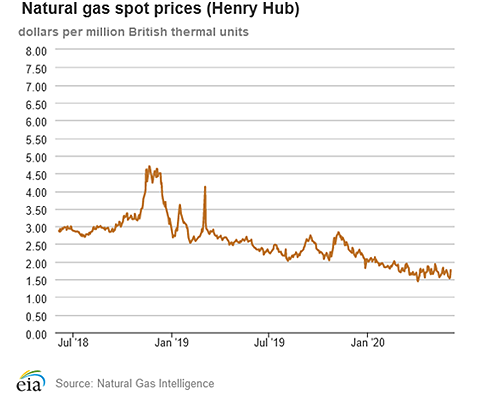
| Spot Prices ($/MMBtu) | Thu, 28-May |
Fri, 29-May |
Mon, 01-Jun |
Tue, 02-Jun |
Wed, 03-Jun |
|---|---|---|---|---|---|
| Henry Hub |
1.69 |
1.60 |
1.53 |
1.56 |
1.77 |
| New York |
1.32 |
1.26 |
1.33 |
1.51 |
1.59 |
| Chicago |
1.64 |
1.53 |
1.54 |
1.65 |
1.78 |
| Cal. Comp. Avg.* |
1.93 |
1.86 |
1.88 |
2.00 |
2.12 |
| Futures ($/MMBtu) | |||||
| July contract | 1.827 |
1.849 |
1.774 |
1.777 |
1.821 |
| August contract |
1.919 |
1.940 |
1.871 |
1.876 |
1.915 |
| *Avg. of NGI's reported prices for: Malin, PG&E Citygate, and Southern California Border Avg. | |||||
| Source: NGI's Daily Gas Price Index | |||||
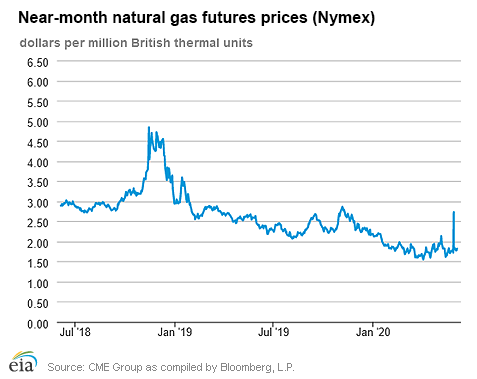
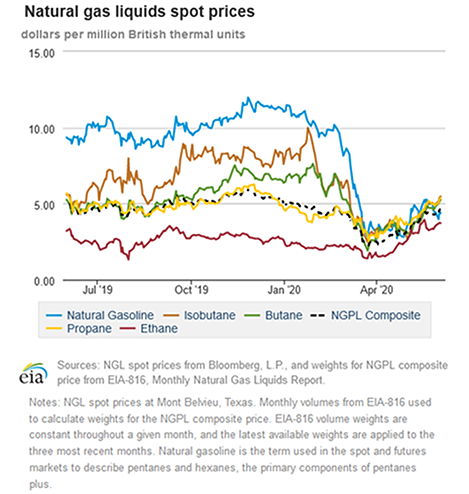
| U.S. natural gas supply - Gas Week: (5/28/20 - 6/3/20) | |||
|---|---|---|---|
Average daily values (Bcf/d): |
|||
this week |
last week |
last year |
|
| Marketed production | 100.7 |
100.1 |
102.0 |
| Dry production | 89.3 |
88.8 |
90.0 |
| Net Canada imports | 4.4 |
4.2 |
4.6 |
| LNG pipeline deliveries | 0.2 |
0.1 |
0.1 |
| Total supply | 93.9 |
93.1 |
94.7 |
|
Source: IHS Markit | |||
| U.S. natural gas consumption - Gas Week: (5/28/20 - 6/3/20) | |||
|---|---|---|---|
Average daily values (Bcf/d): |
|||
this week |
last week |
last year |
|
| U.S. consumption | 62.6 |
60.3 |
62.6 |
| Power | 32.5 |
29.5 |
30.4 |
| Industrial | 20.7 |
20.7 |
21.1 |
| Residential/commercial | 9.5 |
10.1 |
11.0 |
| Mexico exports | 5.0 |
4.8 |
5.2 |
| Pipeline fuel use/losses | 6.1 |
6.0 |
6.2 |
| LNG pipeline receipts | 5.3 |
5.9 |
5.4 |
| Total demand | 79.0 |
77.0 |
79.4 |
|
Source: IHS Markit | |||
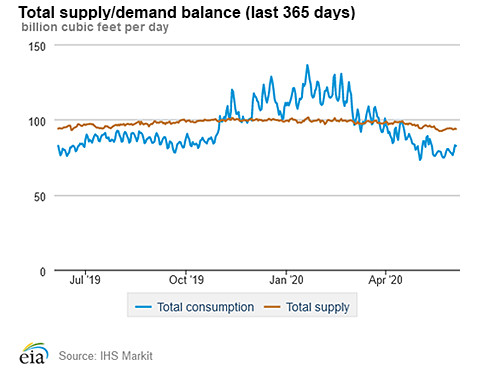
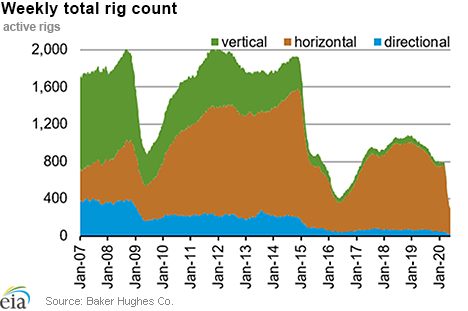
| Rigs | |||
|---|---|---|---|
Tue, May 26, 2020 |
Change from |
||
last week |
last year |
||
| Oil rigs | 222 |
-6.3% |
-72.3% |
| Natural gas rigs | 77 |
-2.5% |
-58.2% |
| Note: Excludes any miscellaneous rigs | |||
| Rig numbers by type | |||
|---|---|---|---|
Tue, May 26, 2020 |
Change from |
||
last week |
last year |
||
| Vertical | 7 |
-12.5% |
-86.5% |
| Horizontal | 271 |
-4.9% |
-68.6% |
| Directional | 23 |
-8.0% |
-67.1% |
| Source: Baker Hughes Co. | |||
| Working gas in underground storage | ||||
|---|---|---|---|---|
Stocks billion cubic feet (Bcf) |
||||
| Region | 2020-05-29 |
2020-05-22 |
change |
|
| East | 536 |
504 |
32 |
|
| Midwest | 634 |
606 |
28 |
|
| Mountain | 140 |
132 |
8 |
|
| Pacific | 273 |
264 |
9 |
|
| South Central | 1,131 |
1,105 |
26 |
|
| Total | 2,714 |
2,612 |
102 |
|
|
Source: Form EIA-912, Weekly Underground Natural Gas Storage Report | ||||
| Working gas in underground storage | |||||
|---|---|---|---|---|---|
Historical comparisons |
|||||
Year ago (5/29/19) |
5-year average (2015-2019) |
||||
| Region | Stocks (Bcf) |
% change |
Stocks (Bcf) |
% change |
|
| East | 405 |
32.3 |
433 |
23.8 |
|
| Midwest | 425 |
49.2 |
489 |
29.7 |
|
| Mountain | 99 |
41.4 |
140 |
0.0 |
|
| Pacific | 209 |
30.6 |
264 |
3.4 |
|
| South Central | 813 |
39.1 |
966 |
17.1 |
|
| Total | 1,952 |
39.0 |
2,292 |
18.4 |
|
| Source: Form EIA-912, Weekly Underground Natural Gas Storage Report | |||||
| Temperature – heating & cooling degree days (week ending May 28) | ||||||||
|---|---|---|---|---|---|---|---|---|
HDD deviation from: |
CDD deviation from: |
|||||||
| Region | HDD Current |
normal |
last year |
CDD Current |
normal |
last year |
||
| New England | 23 |
-19 |
-15 |
12 |
9 |
7 |
||
| Middle Atlantic | 12 |
-20 |
-1 |
16 |
7 |
-1 |
||
| E N Central | 6 |
-31 |
-8 |
46 |
29 |
21 |
||
| W N Central | 10 |
-22 |
-20 |
30 |
8 |
6 |
||
| South Atlantic | 2 |
-9 |
2 |
63 |
13 |
-33 |
||
| E S Central | 1 |
-10 |
1 |
62 |
20 |
-32 |
||
| W S Central | 1 |
0 |
1 |
76 |
6 |
-26 |
||
| Mountain | 43 |
-3 |
-26 |
31 |
2 |
23 |
||
| Pacific | 13 |
-18 |
-42 |
25 |
14 |
25 |
||
| United States | 11 |
-17 |
-13 |
42 |
13 |
-2 |
||
|
Note: HDD = heating degree day; CDD = cooling degree day Source: National Oceanic and Atmospheric Administration | ||||||||
Average temperature (°F)
7-day mean ending May 28, 2020
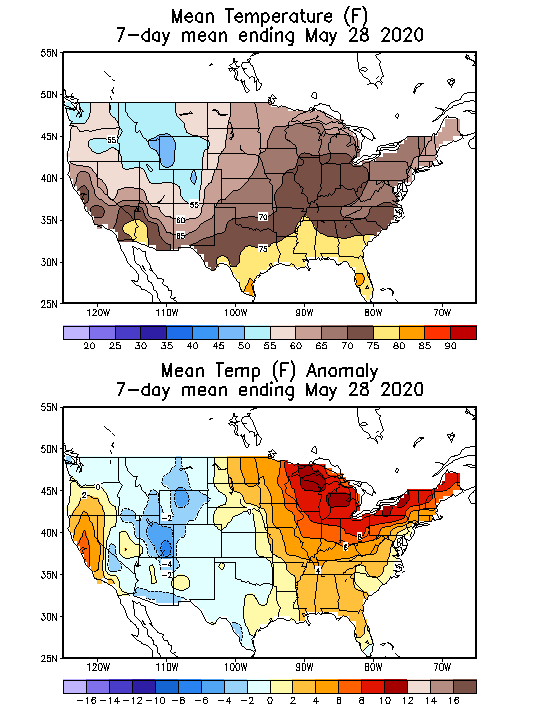
Source: National Oceanic and Atmospheric Administration
Deviation between average and normal (°F)
7-day mean ending May 28, 2020

Source: National Oceanic and Atmospheric Administration

